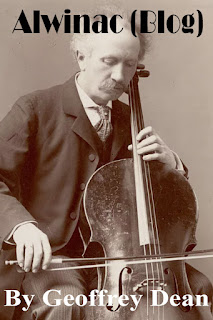 |
| Schroeder with (presumably) his 1824 Pressenda cello [Click on image to go directly to the Alwinac’s home page] |
In the late 1890s, Alwin Schroeder and his family spent their summers in the Rangeley Lakes region of Maine. In her book The Islanders, Elizabeth Foster recalls, “Whenever Grandfather invited [Schroeder], he would accept promptly, adding, ‘— And I will bring my “toothbrush.”’ ‘The toothbrush’ was his pet name for his ’cello.” The only way to reach the Lakes was by narrow-gauge train, but “Schroeder’s ’cello was too large to go through the tiny door of the parlor car, and too valuable to make the journey in the baggage car, so it was always placed on the rear platform where Schroeder could watch it and stop the train immediately if by some dreadful chance it fell off.” At the end of one of his visits, Schroeder had boarded the train to depart from the Lakes, and the train was already pulling out of the station, “when he rushed out on the back platform wildly waving his arms and screaming, ‘Stop the train! Stop the train!’
“‘What’s the matter?’ yelled Grandfather, running after him in an attempt to stop it.…
“‘Mein Gott! I have left my “toothbrush!”’ cried the frenzied musician.
“Grandfather caught up with the engine, and the train backed slowly into the station again, where Schroeder’s ’cello was put on board the rear platform and peace restored to the parlor car.”
The “toothbrush” in question was likely a cello made by Nicolo Amati (1596-1684), a third-generation member of the distinguished family of instrument makers from Cremona, Italy. It came into Schroeder’s possession in or before 1885, when a Leipzig concert review refers specifically to Schroeder's “excellent Amati ’cello.” Two years later Schroeder “sang delightfully on his Amati cello” on another Gewandhaus concert. As he debuted in various American cities during the 1891-2 season, Schroeder garnered critical praise for his playing, but critics did not comment on what make of instrument he might be playing. The old Italian instruments played by the members of the Kneisel Quartet, including Kneisel’s own 1714 Stradivarius violin, became the subject of commentary in the US only after the quartet’s 1896 London concerts, in the wake of English commentary on the superiority of the Kneisels’ instruments to those of other world-class quartets of the time. The Chicago Tribune reported in fall 1897 that “the instruments used by [the Kneisel] quartet are said to have cost $14,000.… Mr. Schroeder of the quartet owns an Amati cello of unusual value.” Elsewhere that value was stated to be $6,000 (about $200,000 in today’s dollars) and the instrument declared to be “one of the finest Amati ’cellos in existence.” I have not found any mention of the year this instrument was made, and only van der Straeten identifies which Amati created Schroeder’s cello, describing it as “one of the most perfect specimens of Nicolas Amati’s work…”
_______________
Read on….
| Copyright © 2022 by Geoffrey Dean |
No comments:
Post a Comment